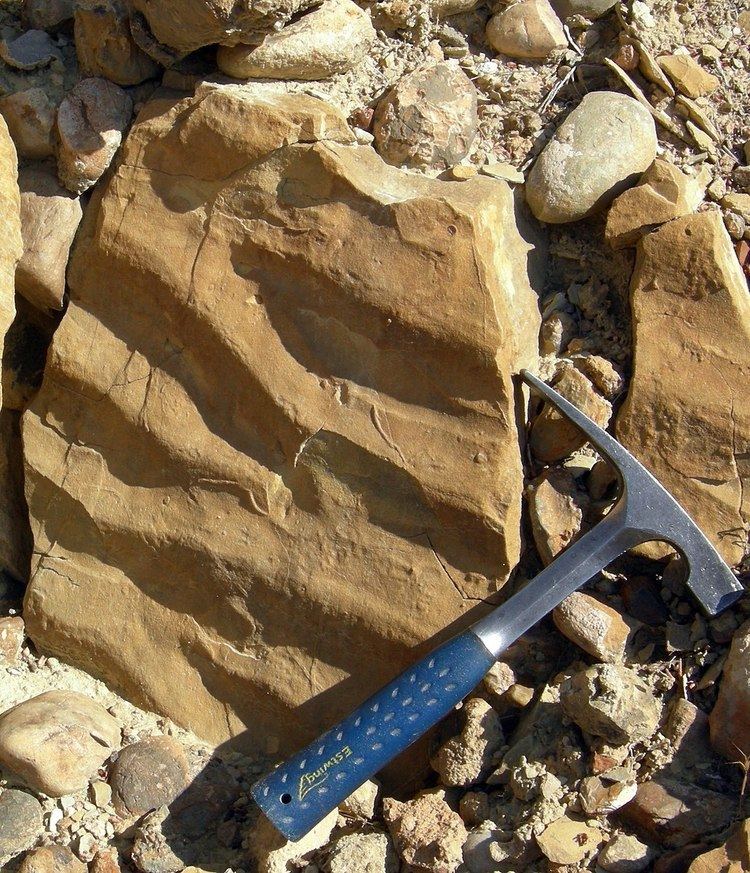 | ||
Sedimentary structures are those structures formed during sediment deposition.
Contents
- Flow structures
- Bedforms vs flow
- Ripple marks
- Antidunes
- Biological structures
- Soft sediment deformation structures
- Bedding plane structures
- Within bedding structures
- Secondary sedimentary structures
- References
Sedimentary structures such as cross bedding, graded bedding and ripple marks are utilized in stratigraphic studies to indicate original position of strata in geologically complex terrains and understand the depositional environment of the sediment.
Flow structures
There are two kinds of flow structures: bidirectional (multiple directions, back-and-forth) and unidirectional. Flow regimes in single-direction (typically fluvial) flow, which at varying speeds and velocities produce different structures, are called bedforms. In the lower flow regime, the natural progression is from a flat bed, to some sediment movement (saltation etc.), to ripples, to slightly larger dunes. Dunes have a vortex in the lee side of the dune. As the upper flow regime forms, the dunes become flattened out, and then produce antidunes. At higher still velocity, the antidunes are flattened and most sedimentation stops, as erosion takes over as the dominant process.
Bedforms vs. flow
Typical unidirectional bedforms represent a specific flow velocity, assuming typical sediments (sands and silts) and water depths, and a chart such as below can be used for interpreting depositional environments, with increasing water velocity going down the chart.
Ripple marks
Ripple marks usually form in conditions with flowing water, in the lower part of the Lower Flow Regime. There are two types of ripple marks:
Antidunes
Antidunes are the sediment bedforms created by fast, shallow flows of water with a Froude number greater than 1. Antidunes form beneath standing waves of water that periodically steepen, migrate, and then break upstream. The antidune bedform is characterized by shallow foresets, which dip upstream at an angle of about ten degrees that can be up to five meters in length. They can be identified by their low angle foresets. For the most part, antidunes bedforms are destroyed during decreased flow, and therefore cross bedding formed by antidunes will not be preserved.
Biological structures
A number of biologically-created sedimentary structures exist, called trace fossils. Examples include burrows and various expressions of bioturbation. Ichnofacies are groups of trace fossils that together help give information on the depositional environment. In general, as deeper (into the sediment) burrows become more common, the shallower the water. As (intricate) surface traces become more common, the water becomes deeper.
Microbes may also interact with sediment to form Microbially Induced Sedimentary Structures.
Soft sediment deformation structures
Soft-sediment deformation structures or SSD, is a consequence of the loading of wet sediment as burial continues after deposition. The heavier sediment "squeezes" the water out of the underlying sediment due to its own weight. There are three common variants of SSD:
Bedding plane structures
Bedding Plane Structures are commonly used as paleocurrent indicators. They are formed when sediment has been deposited and then reworked and reshaped. They include:
Within bedding structures
These structures are within sedimentary bedding and can help with the interpretation of depositional environment and paleocurrent directions. They are formed when the sediment is deposited.
Secondary sedimentary structures
Secondary sedimentary structures form after primary deposition occurs or, in some cases, during the diagenesis of a sedimentary rock. Common secondary structures include any form of bioturbation, soft-sediment deformation, teepee structures, root-traces, and soil mottling. Liesegang rings, cone-in-cone structures, raindrop impressions, and vegetation-induced sedimentary structures would also be considered secondary structures.
